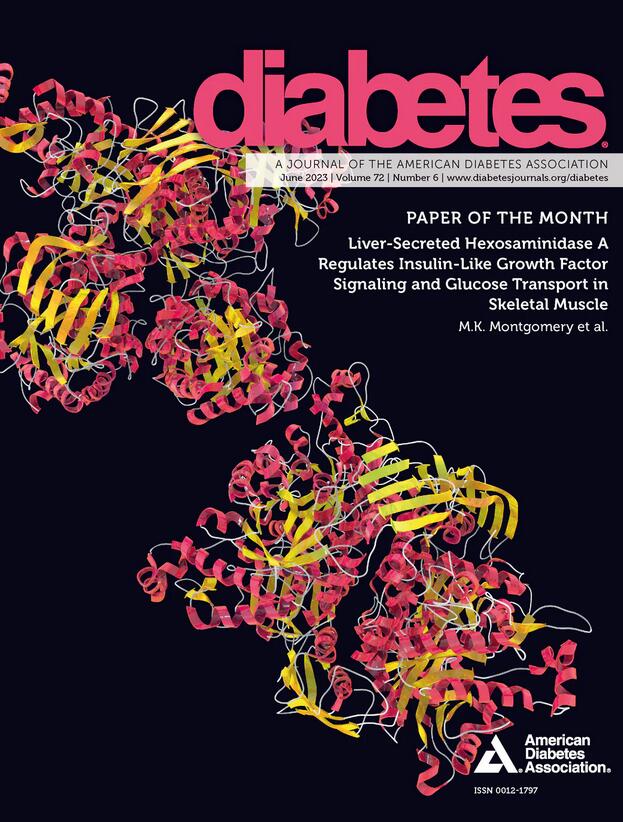1113-P: 利用新型远程医疗诊所管理 2 型糖尿病--为期六个月的试点研究
IF 6.2
1区 医学
Q1 ENDOCRINOLOGY & METABOLISM
引用次数: 0
摘要
简介& 目标:研究旨在评估与标准护理(SoC)相比,糖尿病高级远程医疗(DAT)诊所是否能改善血糖控制。研究方法2型糖尿病(T2D)患者随机接受DAT或SoC治疗。DAT使用连续血糖监测设备、智能胰岛素笔、远程通信(即视频访问)以及运动生理学家提供的体育锻炼(PA)咨询。SoC 使用血糖仪、传统胰岛素笔、上门访问和由医疗服务提供者提供的体育锻炼咨询。主要结果是 HbA1c 的变化。次要结果是在范围内的时间(TIR)70-180 mg/dl、高于范围的时间(TAR)>180 mg/dl、TAR>250 mg/dl和低于范围的时间(TBR)<70 mg/dl。采用方差分析,并对基线值进行调整,以确定组别与结果之间的关系,并报告交互项(组别*时间)的 p 值。运动量通过高级体能测试进行评估,并通过 Hedge's g效应大小进行评估。结果24 名糖尿病患者完成了试验。血糖指标的下降无统计学意义。HbA1c 下降了 2.2%(DAT)与 1.1%(SoC)(-1.1%,[-0.2, -1.8], p=0.076)。TIR 70-180 mg/dL 上升 17.3% vs 15.4% (+1.9%, [-16.1,15.5], p=0.984),TAR>180 mg/dL 下降 20.5% vs 17.9% (-2.6%, [-21.5,10.5], p=0.756),TAR>180 mg/dL 下降 20.5% vs 17.9% (-2.6%, [-21.5,10.5], p=0.756)。756),TAR>250 mg/dL 下降了 17.1% vs 6.0% (-11.1%. [-20.3,2.7], p=0.375),TBR 变化了 0.41% vs -0.88% (+0.47, [-0.16,1.37], p=0.054),DAT vs. SoC 分别如此。60%的参与者完成了体能测试,结果显示,他们在中等力量(二头肌卷曲 g=0.90 /p=0.06, 椅子站立 g=0.63/p=0.18)、日常身体功能(g=0.56/p=0.20)、有氧运动能力(6分钟步行测试 g=0.24/p=0.61)、敏捷性/灵活性(定时起立 g=-0.30/p=0.49, 背部伸展 g=-0.51/p=0.26)方面均有所改善。结论通过DAT治疗的T2D患者的血糖控制得到了非显著性改善,这主要归功于高血糖的减少> 250 mg/dl。观察到 PA 略有增加,但不明显。披露 F. Sotomayor:无。C. Gothong:无:C. Gothong: None.R. Hernandez:无。M.Y. Choe:无。G.I. Ash: None.W.H. Scott: None.L. Pinault:无。F. Gomez-Peralta:Advisory Panel; Abbott.Speaker's Bureau; Abbott.顾问团;礼来公司。Speaker's Bureau; Eli Lilly and Company.顾问团;Insulcloud S.L.演讲事务处;美敦力。顾问团;诺和诺德。诺和诺德公司演讲事务处。顾问团;赛诺菲。L.G. Singh:无。J.D. Sorkin:无。I. Spanakis:研究支持;Dexcom, Inc.本文章由计算机程序翻译,如有差异,请以英文原文为准。
1113-P: Utilizing a Novel Telemedicine Clinic for Managing Type 2 Diabetes—A Six-Month Pilot Study
Introduction & Objective: RCT aimed to assess if a Diabetes Advanced Telemedicine (DAT) clinic leads to improvement in glycemic control compared to standard of care (SoC). Methods: Patients with type 2 diabetes (T2D) randomized to DAT or SoC. DAT used continuous glucose monitoring devices, smart insulin pens, telecommunication (i.e. video visits) with physical activity (PA) counseling by an exercise physiologist. SoC used glucometers, traditional insulin pens, in-person visits and PA counseling by providers. Primary outcome was change in HbA1c. Secondary outcomes were time in range (TIR) 70-180 mg/dl, time above range (TAR)>180 mg/dl, TAR>250 mg/dl and time below range (TBR)<70 mg/dl. ANCOVA was used, adjusted for baseline value to determine the relation between group and outcome, and report p-values of the interaction term, group*time. Exercise was evaluated by senior fitness test and assessed by Hedge’s g effect size. Results: Twenty-four patients with T2D completed the trial. Non-statistically significant reductions in glucose metrics were seen. HbA1c decreased by 2.2% (DAT) vs 1.1% (SoC) (-1.1%, [-0.2, -1.8], p=0.076). TIR 70-180 mg/dL increased 17.3% vs 15.4% (+1.9%, [-16.1,15.5], p=0.984), TAR>180 mg/dL decreased 20.5% vs 17.9% (-2.6%, [-21.5,10.5], p=0.756), TAR>250 mg/dL decreased 17.1% vs 6.0% (-11.1%. [-20.3,2.7], p=0.375), TBR changed 0.41% vs -0.88% (+0.47, [-0.16,1.37], p=0.054), DAT vs. SoC, respectively. Fitness tests, completed by 60% of participants, showed improvements in medium strength (bicep curls g=0.90 /p=0.06, chair stands g=0.63/p=0.18), daily physical function (g=0.56/p=0.20), aerobic performance (6min walk test g=0.24/p=0.61), agility/flexibility (timed up and go g=-0.30/p=0.49, back stretch g=-0.51/p=0.26). Conclusions: T2D patients managed by DAT had non-significant improvement in glucose control driven by decreased hyperglycemia > 250 mg/dl. Non-significant modest increase in PA observed. Disclosure F. Sotomayor: None. C. Gothong: None. R. Hernandez: None. M.Y. Choe: None. G.I. Ash: None. W.H. Scott: None. L. Pinault: None. F. Gomez-Peralta: Advisory Panel; Abbott. Speaker's Bureau; Abbott. Advisory Panel; Eli Lilly and Company. Speaker's Bureau; Eli Lilly and Company. Advisory Panel; Insulcloud S.L. Speaker's Bureau; Medtronic. Advisory Panel; Novo Nordisk. Speaker's Bureau; Novo Nordisk. Advisory Panel; Sanofi. L.G. Singh: None. J.D. Sorkin: None. I. Spanakis: Research Support; Dexcom, Inc., Tandem Diabetes Care, Inc.
求助全文
通过发布文献求助,成功后即可免费获取论文全文。
去求助
来源期刊

Diabetes
医学-内分泌学与代谢
CiteScore
12.50
自引率
2.60%
发文量
1968
审稿时长
1 months
期刊介绍:
Diabetes is a scientific journal that publishes original research exploring the physiological and pathophysiological aspects of diabetes mellitus. We encourage submissions of manuscripts pertaining to laboratory, animal, or human research, covering a wide range of topics. Our primary focus is on investigative reports investigating various aspects such as the development and progression of diabetes, along with its associated complications. We also welcome studies delving into normal and pathological pancreatic islet function and intermediary metabolism, as well as exploring the mechanisms of drug and hormone action from a pharmacological perspective. Additionally, we encourage submissions that delve into the biochemical and molecular aspects of both normal and abnormal biological processes.
However, it is important to note that we do not publish studies relating to diabetes education or the application of accepted therapeutic and diagnostic approaches to patients with diabetes mellitus. Our aim is to provide a platform for research that contributes to advancing our understanding of the underlying mechanisms and processes of diabetes.
 求助内容:
求助内容: 应助结果提醒方式:
应助结果提醒方式:


